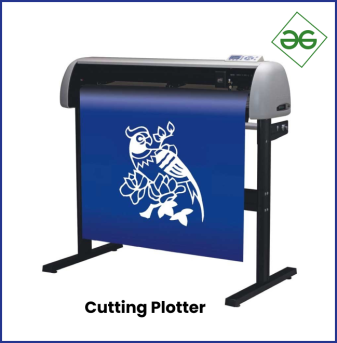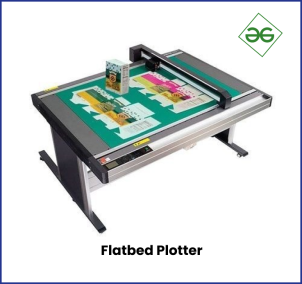Plotter uses multicolored automatic pens to create lines on paper and reads computer orders. It can create charts, maps, graphs, drawings, and more. It uses one or more automated pens to draw a line.
What is a Plotter?
A plotter is basically a type of printer technology. It is a computer output device which is used to to create high-quality images, large-formats images and diagrams and drawings on flat surfaces or papers. It has flatbed which helps in printing on flat surfaces. This device operates on vectors graphics. It is not likely a simple traditional printer that generate images by spraying tiny dots of ink on paper or toner (like deskjet and LaserJet printers) instead plotters uses pens, pencils, or other drawing tools to move across the paper, producing continuous, detailed lines. This device interprets commands from a computer to draw lines on paper with one or more automated multicolored pens. A plotter can draw continuous point-to-point lines directly from vector graphic files or commands.

A Plotter Printer
Need of Plotter
In the mid-20th century when engineers and architects needed a more precise and efficient way to produce technical drawings and diagrams. At that time, before the advent of plotters the technology was not much advance and traditional printers are not much effective and précised for high-quality printing images, maps, charts, diagrams etc. So, the engineers and architects have to use manual techniques such as drafting by hand or using machines like Pantographs, were the primary methods for creating large-scale drawings. These methods were time-consuming, labor-intensive, and more prone to errors. To overcome these problems Plotters are introduced and developed.
One of the earliest plotter was Konrad Zuse’s computer-controlled and transistorized Graphomat Z64 in 1958, also shown at the Hannover Messe in 1961. The first plotter was created by Remington-Rand in 1953. It was used in combination with the UNIVAC computer to make technical drawings.
A number of printer control languages were created to operate pen plotters, and transmit commands like lift pen from paper, place pen on paper, or draw a line from here to here. Three common ASCII-based plotter control languages are Hewlett-Packard’s HP-GL, its successor HP-GL/2, and Houston Instruments DMPL. Here is a simple HP-GL script drawing a simple line:
SP 1; // Select Pen 1
PA 500,500; // Plot Absolute
PD; // Pen Down
PR 0,1000; // Plot Relative
PU; // Pen Up
SP;
Types of Plotter
There are various types of plotter available for various applications, requirements and projects. Following are the types of plotter:
Electrostatic Plotters
In electrostatic plotters, the images are produced on paper by using raster graphics rather than vector graphics. By using toner ink, dot matrix pixels are generated on the paper. The high voltage charges are created on the paper by the plotter, and these charges hit the toner ink for drawing computer-aided designs (CADs). These are much faster and economical in price, but they produce lower quality images than pen-plotters.
.png)
An Electrostatic Plotter
Pen Plotters
It is a type of plotter which use a mechanical pen or pencil to draw lines on paper. They are often used for monochromatic technical drawings and illustrations. Pen plotters are appreciated for their precision and versatility. They provide accuracy and speed which make them popular.

A Pen Plotter
Inkjet Plotters
These type of plotters use inkjet technology and colored inkjet pens to provide high-quality color images and graphics. They are best suitable for applications that require vibrant, detailed output, precision work such as graphic design, architectural renderings, and fine art in a less time. They are commonly used for a large printer, like billboards, banners, and big signs that are used for roadside indication.

An Inkjet Plotter
Cutting Plotters
The cutting plotter is a large-scale cutting machine that uses knives/blades instead of pens to cut the design from a material (such as plastic films or vinyl films) that is lying on the flat surface area of the plotter. The plotter receives a command from the computer, and the knife executes it to cut the media to the appropriate dimensions very precisely. They are commonly used for decals, scrapbooking and cardmaking.

A Cutting Plotter
Drum Plotters
Drum plotters, as name suggests, they use a rotating drum to move the paper left and right while one or more fixed pens write up and down. These plotters are capable of producing large-format images and were popular in the past for applications like map making and technical drawings. The plotter’s ability to draw in numerous colors is enhanced by the use of multiple pens. In some LaserJet printers drums are used to print on the pages.

A Drum Plotter
Flatbed Plotters
A flatbed plotter works with paper that is put on a flat surface in a stationary position. In this plotter, the writing pen moves in both the x and y axes. There are various types of pens available in a number of sizes and colors. The paper lye down on the flat surface while the pen (connected to the moving arm) moves and draws on the paper. The paper’s size is governed by the size of the flat surface on which it is placed. Larger flatbed plotters have the ability to print up to 60-inches in length on the paper. They are capable of printing on other materials such as plastic, cardboard, or even metal.

A Flatbed Plotter
Applications of Plotter
Plotters are widely used in different fields of industries due to their precision and ability to produce large-format, high-quality graphics. Some of them are:
- Architectural and Engineering Industries (CAD,CAE,CAM)
- Graphic Design and Fine Arts
- Education Sector
- Textile and Fabrics Industries
- Advertising and Signage Industries
- Research and Development
- Mapping and Geographic and Information System(GIS)
- Prototyping
Advantages of Plotter
Plotters have several advantages that make them suitable for specific tasks and industries in every field:
- Precision and Accuracy: Plotters are well known for their precision and accuracy, making them perfect for applications that demands detailed, précised and error-free drawings.
- Large Formats: Plotters are good in handling oversized drawings, diagrams and maps. They can handle large paper sizes and media. Large format plotters and wide format plotters are best suitable for this purpose.
- Vector-Based Graphics: Plotters can scale images without loss of quality which means they use vector graphics and point-to-point drawing lines, ensuring that drawings remain sharp and clear at any size and that gives the high quality images.
- Multicolored Output: Plotters are capable of printing high-quality and précised images and diagrams with the help of automated multicolored pens.
- Cutting Capabilities: Cutting plotters are versatile tools which uses knives to cut pieces from materials including vinyl’s, papers, plastic, fabrics, etc.
- Durability: Plotters are much more durable as compared to printers and are designed for long-term commitments and withstand the demands of professionals and industries.
Disadvantages of Plotter
Below is the disadvantages of plotter:
- Speed: Plotters are slower than printers specially when producing high-quality and detailed images
- Cost: Due to their high-quality detailing and precision work they proved expensive economically and maintenance for small businesses and individuals
- Maintenance: Maintaining a plotter is a challenging task than printers. Setting and calibrating a plotter is more complex as compared to printer, requiring careful adjustments for desired output quality.
- Complex setup: Plotters, especially pen plotters, require regular maintenance, including pen replacement, cleaning and calibration, for ensuring high performance.
Difference Between Plotters and Printers
Below is the differences between Plotter and Printer.
|
A plotter is capable of reading the available files in CDR, DWG, CAD, CME, CAE, etc.
|
A printer is capable of reading the available files in formats like JPG TIFF, PDF, BMP, etc.
|
|
A plotter is a device that interprets commands from the computer and then draws its picture on the page with the help of automated pens.
|
A printer is a device that prints texts and images on a page after receiving commands from a network and prints with the help of ink and toner.
|
|
Works at a comparatively slower speed.
|
Capable of working at much faster speed.
|
|
Capable of drawing continuous lines.
|
Not capable of drawing continuous lines.
|
|
CAD, Flexi, Corel, Adobe Illustrator, etc., are some supported softwares.
|
Photoshop and various other image-editing programs are some of the software supported by printers.
|
|
These are less cost-effective and much more expensive.
|
These are more cost-effective and much cheaper.
|
|
The output format of a plotter is similar to that of a vector graphic.
|
The output format of a printer is in the form of pixels, bitmap, etc.
|
|
Examples of plotters are Inkjet plotters, Electrostatic plotters, Pen plotters, Flatbed plotters, Drum plotters, etc.
|
Examples of printers are 3D Printers, Inkjet Printers, LED Printers, Inktank Printers, Laser Printers, Deskjet Printers, Laserjet Printers, etc.
|
FAQs on What is Plotter?
Q.1: What is an average life of plotter printer?
Answer:
On an average a plotter printer lasts for around 3-5 years minimum. Life of an electronic device depends on its maintenance and service and way of handling.
Q.2: What type of papers used in plotters for printing?
Answer:
Plotter printers use special type of papers for printing that are designed for plotter’s technology. Using wrong type of paper can result in poor quality of printing or can damage the printer. These papers are smooth matte surfaced, bright white, uncoated, gloss papers.
Q.3: What type of software plotter used?
Answer:
AutoCAD, Adobe Illustrator, Flexi, Corel Draw, etc are some of the supported softwares for the plotter.
Q.4: How to choose which plotter is best?
Answer:
It all depends on what are your requirements, budget and for what purpose are you using plotter. Whether you are printing CAD or high-end graphics, or you have preference for Inkjet technology or toner-based, or you just need to print color, black-white or both.
Share your thoughts in the comments
Please Login to comment...